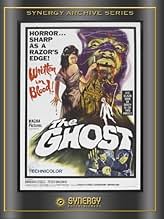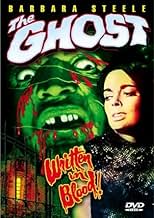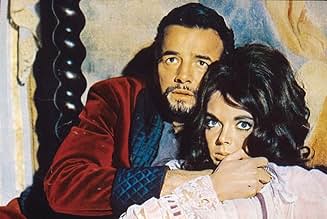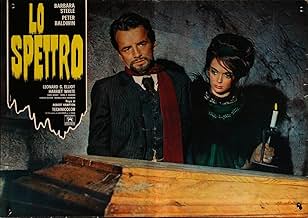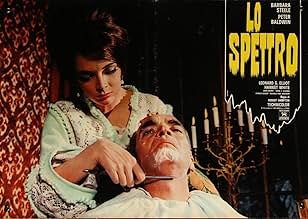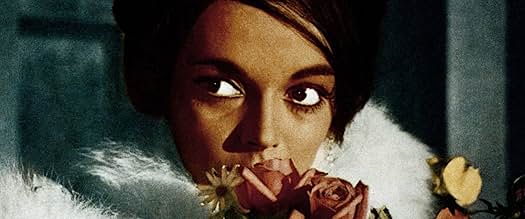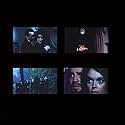CALIFICACIÓN DE IMDb
6.1/10
1.6 k
TU CALIFICACIÓN
Agrega una trama en tu idiomaA woman and her lover murder her doctor husband, but when strange things start happening, they wonder if they really killed him, or if he has come back from the dead to haunt them.A woman and her lover murder her doctor husband, but when strange things start happening, they wonder if they really killed him, or if he has come back from the dead to haunt them.A woman and her lover murder her doctor husband, but when strange things start happening, they wonder if they really killed him, or if he has come back from the dead to haunt them.
- Dirección
- Guionistas
- Elenco
- Premios
- 1 nominación en total
Elio Jotta
- Dr. John Hichcock
- (as Leonard G. Elliot)
Harriet Medin
- Catherine Wood - Housekeeper
- (as Harriet White)
Carlo Kechler
- Police Superintendent
- (as Charles Kechler)
Umberto Raho
- Canon Owens
- (as Raoul H. Newman)
Opiniones destacadas
As you might expect, this film is really quite similar to Riccardo Freda's earlier horror flick "The Terror of Dr Hitchcock", although for my money; I'd say this one is slightly better. The two films share a director and a lead actress in common, as well as a lead character name. This film firmly fits into the 'Gothic' side of Italian cinema, which Steele often starred in, and Freda makes excellent use of this style with some real standout cinematography. It became clear that Riccardo Freda was, in fact, a hack; as it turned out that the great Mario Bava did most of the work on a lot of his films, and his later stuff - Tragic Ceremony and The Iguana with the Tongue of Fire to name a couple - was a million miles away from being brilliant. This film would appear to be Freda at his best, therefore, and it's actually not bad. The plot centres on Dr. John Hitchcock; a cripple who wants to die. His wife is, naturally, having an affair with her husband's doctor, and pretty soon the two of them conspire to murder Dr Hitchcock for his money. However, they didn't bargain for him haunting them after his death...
The film's title suggests that it's a ghost story, but I would say that The Ghost is more of a mystery chiller. There's not a great deal of real bona fide horror, and to be honest; I felt the film was a little too talky and would have proffered it to be a bit more visceral. The film's main draw is, obviously, Barbara Steele and the 'Queen of Horror' looks great throughout the film. The decor and set design is great too, and these allow Freda to build an oppressive and macabre atmosphere, which benefits the plot line quite well. The main problem with the film is the fact that a lot of it feels really amateurish. The dubbing is atrocious (even more so than usual) and some of the things the characters say are ridiculous. Whether or not that's down to the translation, I don't know. The climax is the best part of the film for me. Of course, it's not a completely sense-making ending and there are a few holes left; but it's a nice twist at least, and it does justify the shortfalls of some of the rest of the movie. Overall, I won't go as far as to say that The Ghost is a horror classic; but it's good entertainment, and fans of Gothic horror will enjoy it.
The film's title suggests that it's a ghost story, but I would say that The Ghost is more of a mystery chiller. There's not a great deal of real bona fide horror, and to be honest; I felt the film was a little too talky and would have proffered it to be a bit more visceral. The film's main draw is, obviously, Barbara Steele and the 'Queen of Horror' looks great throughout the film. The decor and set design is great too, and these allow Freda to build an oppressive and macabre atmosphere, which benefits the plot line quite well. The main problem with the film is the fact that a lot of it feels really amateurish. The dubbing is atrocious (even more so than usual) and some of the things the characters say are ridiculous. Whether or not that's down to the translation, I don't know. The climax is the best part of the film for me. Of course, it's not a completely sense-making ending and there are a few holes left; but it's a nice twist at least, and it does justify the shortfalls of some of the rest of the movie. Overall, I won't go as far as to say that The Ghost is a horror classic; but it's good entertainment, and fans of Gothic horror will enjoy it.
This film perhaps holds up better than the first Dr. Hitchcock film and can be seen with or without that film. It stands on its own. A good film for people to be introduced to director Freda's work with. It gets better with repeated viewings and the music score is very good. This is not, just as none of his films are, a supernatural movie. So just know that going in. The film still has a good Gothic feel to it. Sadly there is no really good DVD release version of the film. There is a key and very graphic murder scene that is either cut down or cut completely out of several versions available. Without that being intact the impact of the later part of the film is really reduced. Think about Psycho if you basically cut out the shower scene. Not that this is in Psycho's league but this scene I'm talking about really makes this film work. It would be nice if Freda's films got a box set release of proper versions of his film. He started Mario Bava's career and Argento says Freda had more of an influence on him than Bava was. For now you have to really look hard and watch pretty lousy versions of his films to try to discover him as a director. It's worth the effort but would be nice for him to get some decent releases.
I remember getting my drivers' license. It allowed me to travel to towns a few miles from mine and see movies (only one was shown at a time in those days) at small local theaters. In the sixties we had Vincent Price, Peter Lorre, Sebastian Cabot, and others entertaining us with lightweight, scary little films. Many were based loosely on the works of Poe. Though I never saw this until a few minutes ago, it fits in with that genre. It has wonderful atmosphere. The heroine is not blameless, but has a case for murdering the old meany. Of course, she's going to pay a price, as is her doctor lover, when the old guy comes back to haunt her. There's a little Rebecca and Gaslight here, but it all works nicely to a satisfying conclusion. He who laughs last, of course. The performances are good and the atmosphere of the castle and its bleak goings on is a lot of fun. There is an intensity at work here that build, till people become paranoid and suspicious. See this. It's not a bad ghost story.
Barbara Steele is great as the conniving wife of Dr. Hitchcock in this, Freda's sequel to The Horrible Dr. Hitchcock. She conspires with Dr. Hitchcock's physician (who is also her lover) to do away with her old, sick and wealthy husband, which leads to the old revenge-from-beyond-the-grave storyline. While clichéd and (mostly) predictable, this film remains a must-see for fans of atmospheric horror and, in particular, Italian horror films of the 1960's. Riccardo Freda's excellent work combining lighting, sound and camera movement creates an eerie and foreboding atmosphere which overcomes the films weaknesses and gives healthy punctuation to the films shocks. This movie is well worth tracking down, and is certainly deserving of wider recognition than it has thus far received.
This highly-regarded example of the Italian Gothic Horror style had eluded me until now; even so, having caught up with it at long last, I still wasn't done with the 'Curse Of THE GHOST': the Retromedia DVD proved faulty, with a glitch around the one-hour mark (where the image skipped and the audio dropped out) and then experienced complete freezing after 88 minutes - so much so that I had to finish the film off on another player! This was after a public domain copy I rented from Hollywood when I was there in late 2005 (which, on a hunch, I decided to check before watching) reverted to the Main Menu midway through the climax!!
Anyway, the film itself is undeniably a highlight of the genre and one of Freda's best (which he made in just 12 days): a follow-up, not a sequel, to his previous collaboration with star Barbara Steele - THE HORRIBLE DR. HICHCOCK (1962) - despite the re-use of that notorious character's surname. In the earlier film, too, Steele had been overshadowed by a delightfully manic turn from Robert Flemyng but, here, she lives up to her iconic status as the Queen Of Gothic Horror: few actresses have managed to replicate her sensual mix of wickedness and vulnerability; as for the actor playing Hichcock this time around, who looks a bit like Howard Vernon, he's not too bad - if no match, ultimately, for Flemyng.
Like I said with respect to Hammer's FEAR IN THE NIGHT (1972), the plot twists aren't very original - but they make for a great ride regardless; besides, one could just soak in the colorful visuals (even if the print involved features a lot of wear and tear!). Incidentally, the film is rather gory for its time (witness the 'ghost' exhibiting its decaying flesh and the brutal razor murder, with its wonderful device of having blood dripping across the camera lens to simulate the victim's POV), but the lush score (actually a collection of compositions by Francesco De Masi, Franco Mannino and Roman Vlad - billed under one Americanized name, Franck Wallace!) and a reasonable quota of chills (the creepy scenes where the doctor speaks through his faithful and vaguely sinister housekeeper - played by the ubiquitous Harriet White Medin - who, conveniently, doubles as a medium and the various 'apparitions' - wheelchair stumbling down the stairs, dangling corpse) are certainly par for the course...as is, after all, the film's decidedly languid pace.
The deftly ironic climax is very effective - as a self-satisfied Hichcock expounds on his clever machinations while the immobilized Steele looks horridly on, fully knowing that she'll be blamed for the housekeeper's death and, worse still, that she killed her lover for no reason (i.e. he didn't betray her by stealing the jewels, as she had mistakenly assumed, and these were now once more in Hichcock's hands). The English dubbing isn't too bad considering; however, given the story's Scottish setting, it's odd that only one voice actor would deem it fit to attempt a pertinent accent (i.e. the solicitor who reads Dr. Hichcock's will) - which then causes it to seem unintentionally amusing alongside the less heavy inflections of his fellow dubbing artists!
While Freda is often accused of being indifferent to his films (which he often did purely so as to recoup his gambling losses!), he was undoubtedly a pioneer: not only making the first Italian horror effort, but his masterful use of color in the Dr. Hichcock pictures certainly pushed the genre into that corner - after a solitary stab at it by Giorgio Ferroni in MILL OF THE STONE WOMEN (1960) - as few gothics were shot in black-and-white thereafter (notably three films featuring Steele herself, namely CASTLE OF BLOOD [1964], THE LONG HAIR OF DEATH [1964] and NIGHTMARE CASTLE aka THE FACELESS MONSTER [1965]); certainly, Freda's protégé Mario Bava followed his example...and gradually took over the genre!
Anyway, the film itself is undeniably a highlight of the genre and one of Freda's best (which he made in just 12 days): a follow-up, not a sequel, to his previous collaboration with star Barbara Steele - THE HORRIBLE DR. HICHCOCK (1962) - despite the re-use of that notorious character's surname. In the earlier film, too, Steele had been overshadowed by a delightfully manic turn from Robert Flemyng but, here, she lives up to her iconic status as the Queen Of Gothic Horror: few actresses have managed to replicate her sensual mix of wickedness and vulnerability; as for the actor playing Hichcock this time around, who looks a bit like Howard Vernon, he's not too bad - if no match, ultimately, for Flemyng.
Like I said with respect to Hammer's FEAR IN THE NIGHT (1972), the plot twists aren't very original - but they make for a great ride regardless; besides, one could just soak in the colorful visuals (even if the print involved features a lot of wear and tear!). Incidentally, the film is rather gory for its time (witness the 'ghost' exhibiting its decaying flesh and the brutal razor murder, with its wonderful device of having blood dripping across the camera lens to simulate the victim's POV), but the lush score (actually a collection of compositions by Francesco De Masi, Franco Mannino and Roman Vlad - billed under one Americanized name, Franck Wallace!) and a reasonable quota of chills (the creepy scenes where the doctor speaks through his faithful and vaguely sinister housekeeper - played by the ubiquitous Harriet White Medin - who, conveniently, doubles as a medium and the various 'apparitions' - wheelchair stumbling down the stairs, dangling corpse) are certainly par for the course...as is, after all, the film's decidedly languid pace.
The deftly ironic climax is very effective - as a self-satisfied Hichcock expounds on his clever machinations while the immobilized Steele looks horridly on, fully knowing that she'll be blamed for the housekeeper's death and, worse still, that she killed her lover for no reason (i.e. he didn't betray her by stealing the jewels, as she had mistakenly assumed, and these were now once more in Hichcock's hands). The English dubbing isn't too bad considering; however, given the story's Scottish setting, it's odd that only one voice actor would deem it fit to attempt a pertinent accent (i.e. the solicitor who reads Dr. Hichcock's will) - which then causes it to seem unintentionally amusing alongside the less heavy inflections of his fellow dubbing artists!
While Freda is often accused of being indifferent to his films (which he often did purely so as to recoup his gambling losses!), he was undoubtedly a pioneer: not only making the first Italian horror effort, but his masterful use of color in the Dr. Hichcock pictures certainly pushed the genre into that corner - after a solitary stab at it by Giorgio Ferroni in MILL OF THE STONE WOMEN (1960) - as few gothics were shot in black-and-white thereafter (notably three films featuring Steele herself, namely CASTLE OF BLOOD [1964], THE LONG HAIR OF DEATH [1964] and NIGHTMARE CASTLE aka THE FACELESS MONSTER [1965]); certainly, Freda's protégé Mario Bava followed his example...and gradually took over the genre!
¿Sabías que…?
- TriviaMade during the pseudonym craze of the 1960s, the music score was credited to "Franck Wallace." Italian composers usually registered their pseudonyms with their performing right society, the SIAE, and the identities were listed by Bianco e Nero and the Monthly Film Bulletin who both reported that Wallace was Franco Mannino. However, some reference sources such as Donald C. Willis in 1972 suggested "Franck Wallace" was a joint pseudonym for Mannino and Roman Vlad (the two composers sometimes collaborated and Wallace is a very rough transliteration of Vlad). Even more confusingly, Beat Records released the soundtrack in 2008 and discovered that the surviving tapes in the Nazionalmusic vaults were attributed to Francesco De Masi. So the CD went out credited to De Masi only. De Masi did not work with either of the other two composers, instead being asked at the behest of the director to do a new score, not liking Mannino's effort; what portions thereof are contained in the film, are unknown, as the director seemingly changed his mind again, as Mannino is credited in the film for the score.
- ErroresWhen Dr. Livingston removes the bullet from the wall, there is a close-up of him holding an entire cartridge in his hands.
- Citas
Dr. John Hichcock: [hands around Margaret's throat] Feel how strong my grip is? But I won't kill you.
- ConexionesFeatured in 100 Years of Horror: Ghosts (1996)
Selecciones populares
Inicia sesión para calificar y agrega a la lista de videos para obtener recomendaciones personalizadas
2025 Venice Film Festival Guide
2025 Venice Film Festival Guide
See the full lineup for the 2025 Venice Film Festival, taking place Aug. 27 – Sept. 9, 2025.
- How long is The Ghost?Con tecnología de Alexa
Detalles
- Fecha de lanzamiento
- País de origen
- Idioma
- También se conoce como
- The Ghost
- Locaciones de filmación
- Blair Drummond House, Cuthil Brae, Stirling, Scozia, Reino Unido(castle-location)
- Productora
- Ver más créditos de la compañía en IMDbPro
- Tiempo de ejecución
- 1h 37min(97 min)
- Mezcla de sonido
- Relación de aspecto
- 1.85 : 1
Contribuir a esta página
Sugiere una edición o agrega el contenido que falta

